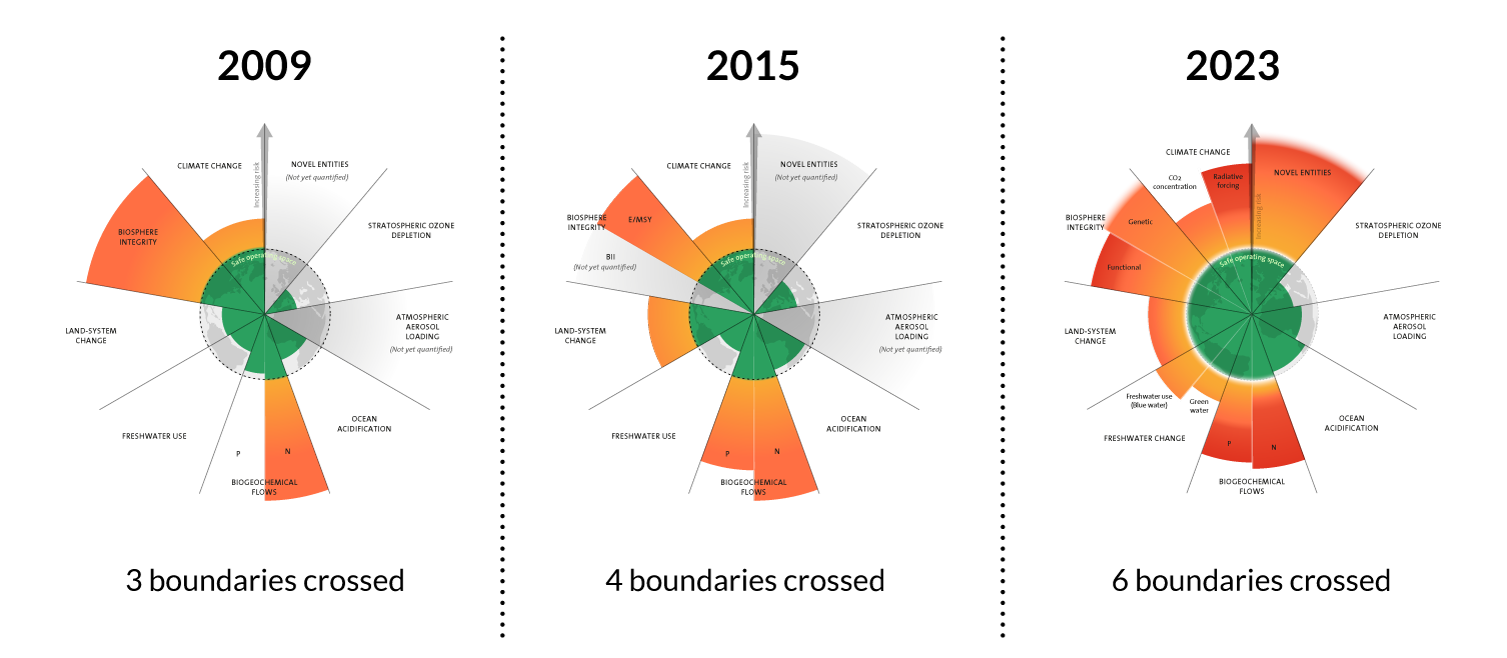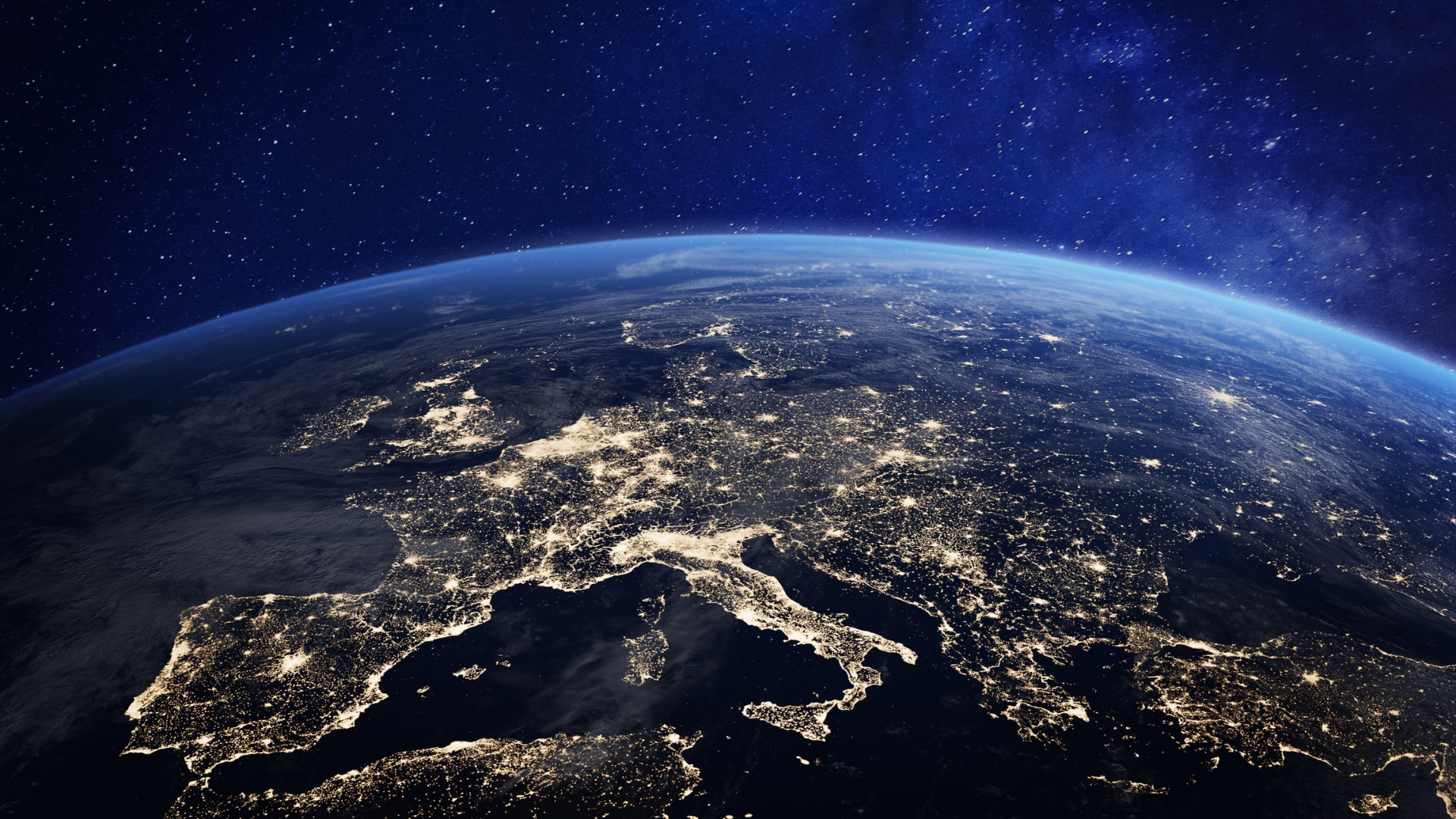We’ve breached six of nine planetary boundaries
Written by Olivia Nater | Published: October 10, 2023
…and there’s only one way to fix it
A major scientific analysis has revealed that humanity has broken six out of nine planetary boundaries, including for climate change, biodiversity loss, and freshwater use, meaning we face a high risk of sudden or irreversible environmental changes.
The study, published in the journal Science Advances, is an update of the planetary boundaries framework, developed in 2009 by scientists at the Stockholm Resilience Centre to quantify a “safe operating space” for humanity and provide a holistic picture of our impact on the environment.
For the first time, the team of scientists behind the framework has quantified all nine planetary boundaries, demonstrating that we’ve passed the safety threshold for all of them except for ocean acidification, ozone depletion, and air pollution.
The scientists warn that the degree of transgression of previously breached boundaries has increased since the previous updates, and say the study serves as “a renewed wake-up call to humankind.”
As a baseline for their calculations, the team used the state of the planet during the Holocene, which began around 11,700 years ago and was marked by a relatively stable environment and a small, pre-industrial human population. Despite a lack of agreement of when it officially started, the scientific consensus is that we are now in a new period, the Anthropocene, defined by humanity’s huge impact on the planet.

Biosphere integrity and land system change
The study uses two variables to measure our impact on biodiversity: genetic diversity and functional integrity, the latter measured by human appropriation of primary production (energy produced by plants), mainly as a function of land use change and harvesting. With an estimated one million species now threatened with extinction, over 10% of the genetic diversity of plants and animals estimated to have been lost over the past 150 years, an accelerating extinction rate, and increasing exploitation of wild species, the authors deem we exceeded the safe boundary for biosphere integrity in the 19th century are now in the “high risk” zone.
Forest loss was used to calculated land system change, with the boundary defined as the preservation of a weighted average of 75% of the forest cover present in the Holocene, including 85% of tropical forest, 50% of temperate forest, and 85% of boreal forest. The study estimates that only 60% of global forest cover remains, with tropical, temperate, and boreal forest cover in several geographic areas significantly lower than the thresholds, and continuing to decrease. We are thus very close to the “high risk” zone for this breached boundary.
Climate change and ocean acidification
For climate change, the boundary was set at 350 parts per million (ppm) of CO2, which corresponds to approximately 1° to 2°C of global warming. We exceeded this level in the late 1980s and are now at 417 ppm and counting, with current policies putting us on track for a 2-3°C temperature rise by 2100, well beyond the 1.5°C target identified in the Paris Agreement. Models show that exceeding the 1.5°C target is associated with a high risk of triggering irreversible, dangerous tipping points. As a result of increasing greenhouse gas emissions, we’ve also breached the safety limit for radiative forcing, which means significantly more energy from sunlight is reaching Earth than is radiated to space.
Ocean acidification is a byproduct of increasing CO2 emissions — the absorption of carbon dioxide by the oceans causes them to become more acidic, which compromises the structural integrity of corals and shellfish. While the planetary boundary for ocean acidification has not yet been exceeded, the authors estimate that current acidification levels are now right up against the threshold.
Freshwater change and biogeochemical flows
To measure changes in freshwater availability, the study looked both at surface and groundwater (“blue water”) as well as water available to plants as soil moisture (“green water”). Freshwater use has increased substantially as a result of human population growth and agricultural expansion, with a quarter of the global population now using at least 80% of their countries’ available freshwater every year.
Due to significant changes in both blue and green water availability since pre-industrial times, the authors estimate that the planetary boundary for freshwater was likely breached in the first half of the 20th century.
Biogeochemical flows refer to the flow of nitrogen and phosphorus in the environment, plant nutrients used in agricultural fertilizers. These can cause problems when large quantities enter rivers and the ocean, leading to harmful algal blooms and ocean dead zones. The paper notes that the UN Food and Agriculture Organization (FAO) estimates that the amount of nitrogen applied to cropland every year is close to 190 trillion grams, which is more than three times the authors’ determined safe level. The boundary for biogeochemical flows is therefore significantly overstepped.
Atmospheric aerosol loading and “novel entities”
Atmospheric aerosol loading is a measure of particulate air pollution, which originates from fossil fuel combustion, wildfires, and dust. While particulate air pollution presents a major threat to human health, this paper only looked at its impact on planetary stability. A high concentration of aerosols in the atmosphere impacts weather patterns, such as rainfall, as well as the amount of sunlight reaching the Earth’s surface. According to the scientists’ analysis, we have not yet reached the planetary boundary for aerosols at a global level, but areas with high pollution levels, including southern Asia, are estimated to already have exceeded the safety threshold.
“Novel entities” is the term used to describe relatively new pollutants, such as microplastics, endocrine disruptors, and nuclear waste, which have been rapidly accumulating in recent decades. The authors argue that the precautionary principle should be employed for these pollutants, as their long-term effects on Earth’s systems are still largely unknown. As previous large-scale release of poorly studied chemicals, such as DDT, had disastrous effects, the authors set the planetary boundary at zero release of synthetic chemical compounds unless they have been certified as harmless and are monitored. The boundary is therefore hugely exceeded.
A bittersweet success story: ozone depletion
Ozone depletion represents the one planetary boundary for which we actually succeeded in making progress. In the past, chlorofluorocarbons (CFCs) were used widely as refrigerants, propellants, and solvents, but when CFCs enter the atmosphere, they deplete the ozone layer, meaning more damaging UV-B radiation reaches the Earth’s surface. CFCs were phased out following the ratification of the Montreal Protocol in 1987 — the only UN treaty ratified by every country on the planet. As a result, the ozone layer has recovered slightly and we are now within the safe operating space for this boundary.
There was a downside, however. CFCs were largely replaced by hydrofluorocarbons (HFCs), which don’t harm the ozone layer but are highly potent greenhouse gases. In recognition of this climate threat, the Kigali Amendment was adopted in 2016, with the aim to phase down future global production and consumption of HFCs too. Research into alternatives is underway, yet it is clear they all entail some kind of trade-off.
Technofixes alone won’t save us
Growth enthusiasts believe we can fix all our environmental crises through innovation — new chemicals, new forms of energy generation, etc. They ignore, however, that these technofixes often replace one problem with another, because without efforts to shrink our human footprint, we will always come up against planetary limits.
The only way to permanently return to the safe operating space of all nine planetary boundaries is to accept that a finite planet cannot support infinite growth. This means stabilizing our human population and consumption at a level that can be sustained by Earth’s resources and that allows for a healthy, thriving environment.

